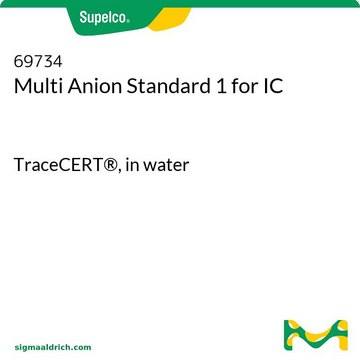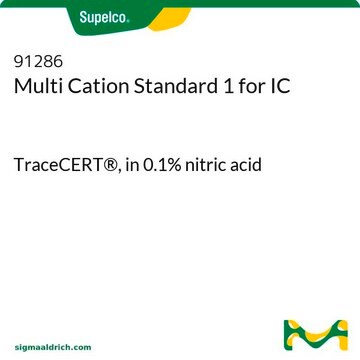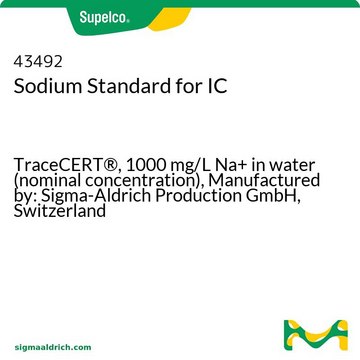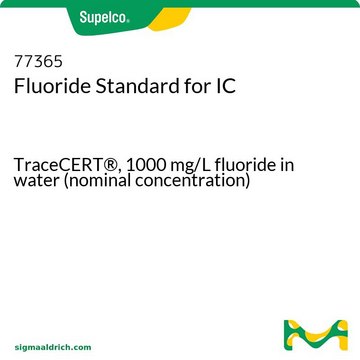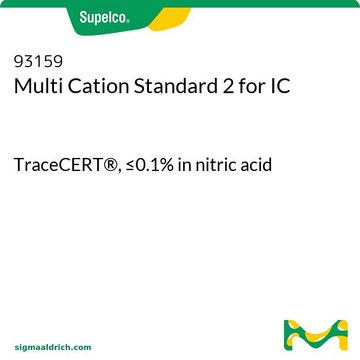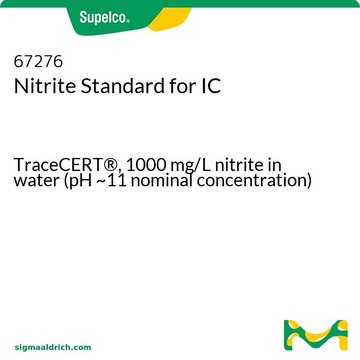89886
Multielement Ion Chromatography Anion Standard Solution, certified
suitable for ion chromatography, TraceCERT®, certified reference material traceable to SI, 10.0 mg/kg F-, Cl-, Br-, NO3-, PO43-, SO42- each anion
Synonym(s):
Certified Multielement Ion Chromatography Anion Standard Solution
Sign Into View Organizational & Contract Pricing
All Photos(1)
About This Item
UNSPSC Code:
41116107
NACRES:
NA.24
Recommended Products
grade
certified reference material
TraceCERT®
Quality Level
product line
TraceCERT®
technique(s)
ion chromatography: suitable
application(s)
environmental
food and beverages
format
multi-component solution
Application
It is intended to be used during the calibration of ion chromatography-based analytical techniques.
Features and Benefits
- Produced under ISO/IEC 17025 and ISO 17034 accreditation
- Traceable to SI unit of mole through internationally accepted institutions such as NIST or BAM
- Accompanied by a comprehensive Certificate of Analysis (CoA) (up to four pages) with data on stability, density, homogeneity, the accuracy of concentration, uncertainty, and traceability
- Gravimetrically prepared using high-quality qNMR-characterized starting materials and qualified precision balances to ensure minimal uncertainty
- Rigorously tested through real-time stability studies to ensure accuracy and shelf life
- Available in an HDPE bottle, sealed in an aluminum bag
Linkage
Visit the IC Portal to learn more
Analysis Note
Produced with certified high purity materials (NaF, NaCl, NaBr, NaNO3, Na2HPO4, Na2SO4) and ultrapure water (18 MOhm, 0.22 μm filtered)
Legal Information
TraceCERT is a registered trademark of Merck KGaA, Darmstadt, Germany
Storage Class Code
12 - Non Combustible Liquids
WGK
nwg
Flash Point(F)
Not applicable
Flash Point(C)
Not applicable
Personal Protective Equipment
dust mask type N95 (US), Eyeshields, Gloves
Choose from one of the most recent versions:
Already Own This Product?
Find documentation for the products that you have recently purchased in the Document Library.
Nicole A P van Gestel et al.
Journal of materials science. Materials in medicine, 30(8), 94-94 (2019-08-16)
Clinically, S53P4 bioactive glass (BAG) has shown very promising results in bone infection treatment, but it is also known to degrade very slowly in vivo. To evaluate which mechanisms (cellular or dissolution) can play a role in the degradation of
Our team of scientists has experience in all areas of research including Life Science, Material Science, Chemical Synthesis, Chromatography, Analytical and many others.
Contact Technical Service
